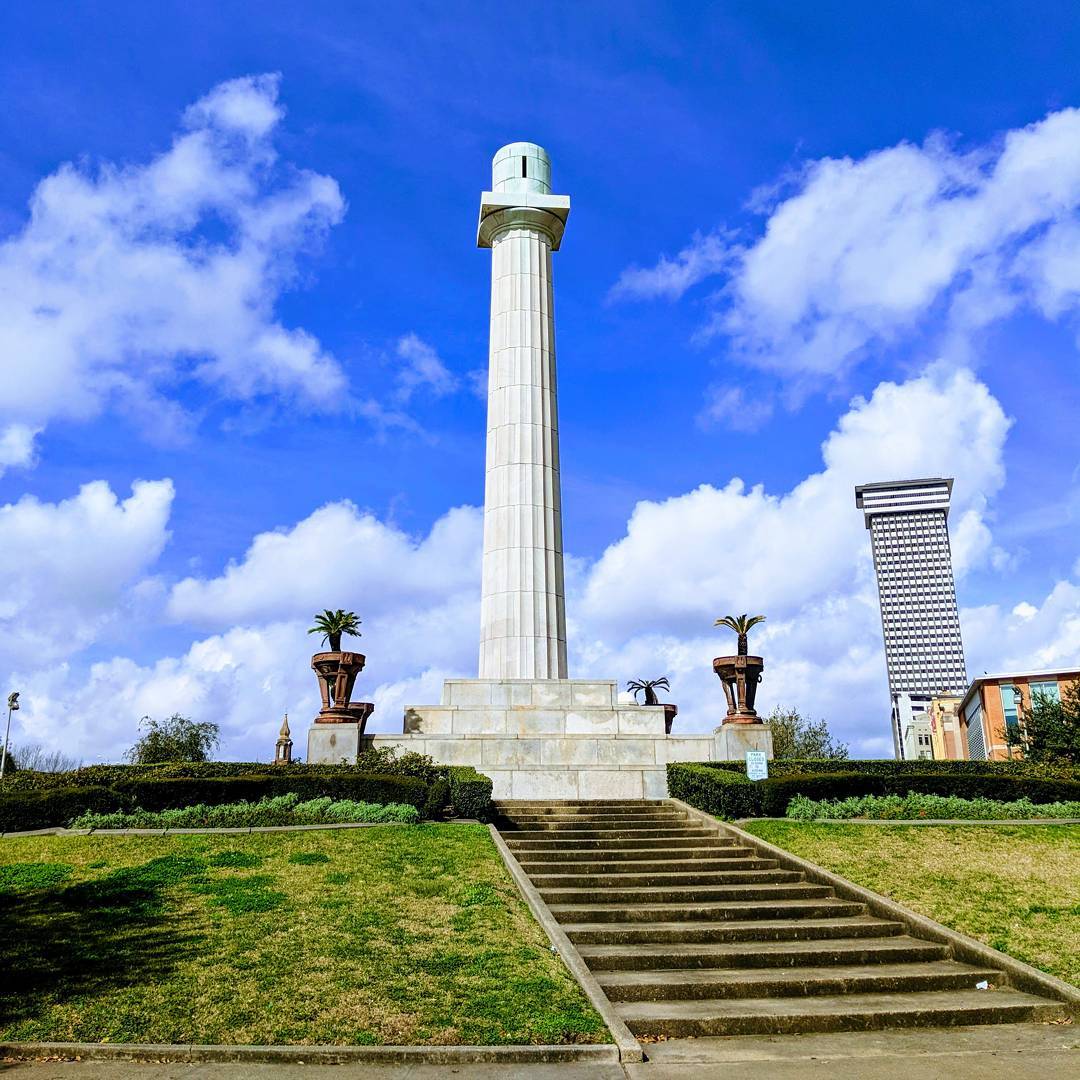
The empty pedestal at Lee Circle, New Orleans. February 20, 2018. (Photo by author)
A year ago, Civil War Times Magazine published “Empty Pedestals: What should be done with civic monuments to the Confederacy and its leaders?” The article comprises a series of paragraph-length blurbs from various thinkers responding to the question. Taken together, the reader gets a decent snapshot of the spectrum of rationalizations Confederate monument apologists have invented to justify some degree of compromise softer than outright removal. There are a range of Confederate monument apologists, not all of them acting in bad faith necessarily, but all of them in one way or another stretching to justify the perpetuation of these white supremacist monuments celebrating a pernicious fictional alternate history. Here are some of the justifications:
Edification: “Confederate monuments can be used as tools for education” (James J. Broomall) where “conflicting interpretations of circumstances might be highlighted” (Catherine Clinton). Historian Ethan S. Rafuse fears that removing memorials would be to “lose the fodder for discussion.” These explanations lean on the strange assumption that only things which are physically present can be of use in educational settings. This assumption is tenuous at best. Since when does a thing need to be physically present to be a topic of discussion? A lesson about the Confederacy could just as well be structured around a discussion about why a thing isn’t present. What better way to spark a discussion about the Confederacy that is not, than an empty pedestal?
Scholar Megan Nelson offered a reasonable compromise. “Confederate memorials should neither be retained nor removed: They should be destroyed, and their broken pieces left in situ.” They would certainly still be edifying in that case — satisfying Rafuse’s concern about removing discussion fodder. Another popular option is to remove them to monument graveyards, as has been done in Moscow and Budapest.
Aesthetic Value: Lincoln scholar Harold Holzer argues that “Not all art is easy to digest… Do no local museums exist in these cities willing to reinstall, or properly label, the worthiest example of the post-Civil War memorial movement?” This argument puts Holzer in the awkward position of having to explain the aesthetic merit of each individual monument he would have accessioned in a museum, a position made tougher by the fact that a large number of these monuments were mass-produced on the cheap. That is part of the reason they are so easy to tear down. That said, Holzer isn’t against removing monuments, so we might call this position “weak” Confederate monument apologism.
False Equivalency: Robert K. Krick writes:
“It is impossible to imagine a United States in the current atmosphere that does not include zealots eager to obliterate any culture not precisely their own, destroying monuments in the fashion of Soviets after a purge and antiquities in the manner of ISIS. The trend is redolent of the misery that inundated the planet during the aptly named Dark Ages, arising from savages who believed, as a matter of religion in that instance, that anyone with opinions different than their own was not just wrong, but craven and evil, and must be brutalized into conformity.”
Krick’s out-of-touch rant, steeped in racist diction (“savages”), overlooks that nobody who studies the so-called “aptly named Dark Ages” calls them the “Dark Ages” anymore.1 But more importantly, it misses the point. The Civil War was explicitly about “obliterating” a specific culture: the culture that wanted to preserve their right to own other human beings. The people he calls “zealots” are the people today who want to remove Confederate monuments to slavery and white power. The “culture not precisely [the zealots’] own” that he refers to is the Confederate culture of historical revisionism — a culture that Krick seems to consider his own. If not wanting to preserve and celebrate monuments to slavery makes me a zealot, then I agree, zealously. It’s fair to call Krick’s position “strong” Confederate monument apologism.
Slippery Slope Fallacy: Historic Preservationist Joseph McGill argues:
“In this sanitizing of history, we will eventually get to our Founding Fathers, some of whom were slave owners. How would Washington, D.C., look without the Washington Monument or the Jefferson Memorial.”
Sure. And after that we will have to burn down the White House, which was built by enslaved peoples, twice. No one (except McGill and Donald Trump) thinks that the stakes of the removal argument include the Washington Monument or Jefferson Memorial, because the slippery slope fallacy is just that: a logical fallacy.
Erasing History: I suppose it shouldn’t come as a surprise that the Commander-in-Chief of the Sons of Confederate Veterans, Thos. V. Strain, Jr., thinks that “these removals are an attempt to erase history.” The irony of this argument is that Confederate monuments were explicitly designed to erase history. These monuments would have us believe that the Civil War wasn’t about white power and the right to own human beings, but rather the noble effort of the South to protect States’ rights with all the pride and dignity and tragedy of Gone with the Wind. As much as this apologist would like you to think otherwise, removing Confederate monuments is not erasing history: it is about recognizing fiction.
Ultimately, I found myself nodding vigorously in agreement with West Point curator Michael J. McAfee’s laconic position on the matter of Confederate monument removal:
There is a “reason there are no monuments that mention the name Benedict Arnold.”
